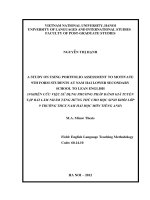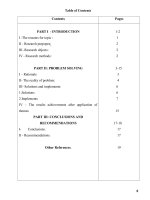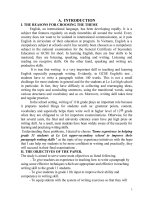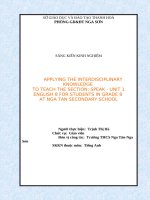Some experiences in guiding students in grade 8 at nhu ba sy secondary school to learn english pronunciation part more effectively
Bạn đang xem bản rút gọn của tài liệu. Xem và tải ngay bản đầy đủ của tài liệu tại đây (701.67 KB, 19 trang )
1. INTRODUCTION
1.1. Reason for choosing the reseach.
Vietnam is in the process of integration and cooperation with the world
community. That requires a lot of factors to successful integration. One of those
factors is the foreign language and English is an international language and it
helps our integration success in all aspects. In other words, English is the key to
success. The teaching and learning of English in secondary schools has its own
advantages and challenges, requires teachers to constantly strive to improve the
qualifications, expertise and pedagogical. As an English teacher with over ten
years of experience, I realize that there exist many problems in teaching and
learning English, including Phonetics section of students. Most students master
knowledge of grammar well, but when doing homework about phonetics
students are afraid and worried. In my opinion, there are two basic reasons for
this: first, theoretical part of learning about phoneics is very troublesome and
confusing. Second, students do not have a favorable environment for
communication or in other words the environment to practice what they just
learned is weak.
It is also the root causes leading to poor listening and speaking skills of
learners. Fortunately, the program English textbooks 8 (new) has a dedicated
section for the pronunciation. To teach and learn this part effectively, I boldly
choose the theme: "Some experiences in guiding students in grade 8 (new) at
Nhu Ba Sy secondary school to learn Pronunciation part effectively ." And I
think that choosing my subject is necessary and appropriate at the time now
when new textbooks are being taught in some schools in our district.
1.2. Research purposes.
I chose this research topic to help teachers with the training tips section to
teach pronunciation to achieve greater efficiency and help the learners more
confidence in communication. Since then communication will lead to success. It
is the output of the language and the best result of learning a language.
1.3. Research objects.
This topic I will research on how to guide students in grade 8 at Nhu Ba
Sy secondary school to pronounce module in the program 8 English textbooks
effectively.
1.4. Research methods.
I have chosen method Schroeder survey, collecting information to perform
the subject.
2. CONTENTS:
2.1. The theoretical basic:
Everyone knows the basis of the following reasoning:
Tell me -> I will forget
Show me -> I will remember
Let me join -> I will understand
1
While teaching English, teachers should let students participate in
activities as much as possible. For example, for students to participate in
learning through games that will help students understand and remember it.
2.2 .The realities of the research issue:
When I didn’t apply those methods in teaching students how to pronounce
in grade 8 term I (2015- 2016 school year) , I received unsatisfactory results,
which is presented in the following statistical tables:
School year
2015-2016
Term 1
Grade 8
Total students: 122
Classify
Medium
students
1
0,9%
student
Fairly good
students
27
22,1%
students
Good
students
94
77%
students
2.3. Implementation and solutions:
To solve this matter, I divide them into two parts. The first is some cluters
and the second is some rules of stress.
a. Guiding students to learn some cluters:
In English text book 8, students will master some clusters in couples: /br/
and/pr/; /bl/ and / cl/; /sk/ ,/sp/ and /st/.
In unit 1, students will learn /br/ and /pr/. Firstly, teacher can ask students to give
examples of words that contains the clusters: /br/ and /pr/. Teacher may divive
class into 2 or 4 groups to play a game. In 5 minutes, which group can find more
words will be the winner. This help students feel eager to study.
2
/br/
/pr/
Brige, brown, bring, bread, bracelet, Prince, princess, president, present,
brocoli, brick, brush, branch, broom.
presentation, apricot,prawns, prize.
After that, teacher let students listen and repeat those words according to
tapecrips in text book. There are some ways to check again these words. Teacher
can ask students to play jumble words or write the words under each picture.
1.prince
4……………….
6……………..
2. ……………….
3……………………
5………………..
7………………….
3
8…………………
9…………….
10………………….
11………………… 12………………
13…………………..
14……………….
16……………..
15…………………….
17……………………..
Teacher can do the same stage with the clusters/bl/ and/ cl/.
Students can call out those words in groups or individually:
/bl/
/cl/
Blue, blossom, blackberry, blind, Class, clock, cloud, clown, clothes,
bloom,
blame,
blast,
block, clay, climb, close, club, claim, click,
blow,blouse
clue, clean
To check again these words teacher can ask students to write again the
words based on the pictures.
4
1. blue
2………………..
4……………….
3……………
5………………….
6…………………..
7………………….
8 ………………..
9 ……………
5
10…………………
11…………………..
12………………………………..
If any words we can’t express by pictures, teacher can ask students to play
jumbled words: examples: lmbea ( blame), lsatb( blast), locbk( block),
luec( clue), ealcn( clean)………….
Another way to check is that teacher can ask students to make as many
sentences as possible with the words they have learnt.( or play chain game)
EX: S1. Look at the clear blue sky.
S2: Look at the clock. It’s time for you to go to bed.
S3: Close the door.
S4: Do you want to see a clown.
S5:……………………………………………
In unit 3 students will learn 3 clusters: /sk/, / sp/, /st/.
Teacher can use exercise 1 in Exercise book 8( page 16) to elicit this
phonetic.
Teacher asks students to use the correct spelling for sounds /sk/, /sp/, /st/
under each picture:
1.____ateboard.
2. ___ation
3. __ool
6
4. ___adium
5. _____orts
6. fe__ival
6.____ aceship
7. __ilt house
8. ___icky rice
7
9. di___lay
In page 40 English 8, students will learn clusters : / spr/ and / str/.
To help students remember the words which has these two clusters, teacher can
ask students to play a game. Students can work in pairs. One student take a
picture as below, another one has to call out its name in English. All the words
have the cluster /spr/ or / str/.
1.____straw__________________
3.________________
2._____________________
4._________________________
8
5.___________________
7._________________
9.______________
6.______________________
8._______________
10.____________________
9
11._________________
12. _____________________
The other students listen and comment whether their classmates are right or
wrong. If they are wrong, other students can correct.Teacher is a guide or a
council.
b. Guiding students how to mark stress correctly and pronouce them
exactly.
Most students are worried to learn the rules about stress and do exercises about
this. Teacher can help students to have some small tips so that they can be
confident to learn this part.
In unit 5 English text book 8, students will learn the rules of the stress of the
words ending in – ion and – ian. To help students to master this part well,
teacher can let students work in groups so that they can find as many words
which have ending –ion or –ian as possible.
Ex: competition, preservation, commemoration, procession, confusion,
magician, electrician, technician, companion, historian, congratulation,
celebration, vegetarian, production, librarian, polictician, attention,
participation…….
Teacher takes note that most of the words ending in –ion or – ian are usually
nouns. Furthermore, to mark the stress of these words: stress the syllable
immediatetly before the suffix: - ion or – ian.
After that, teacher may ask student to work in pairs to mark the stress of the
words they have found:
compe’tition, preser’vation, commemo’ration, pro’cession, con’fusion,
ma’gician, elec’trician, tech’nician, com’panion, his’torian, congratu’lation,
celeb’ration, vege’tarian, pro’duction, lib’rarian, polic’tician, a’ttention,
partici’pation…….
To check again the words teacher may ask students to complete the words below
the pictures with – ian or – ion then mark stress syllable in each word.
10
1.
ma’gician _________
3.________________
5__________________
2.________________________
4.________________________
6._________________
11
.
7._________________________________
8._____________________
In Unit 7, students will learn the stress of the words endings in - ic and al
Teacher may do as above or another way is that: Teacher ask student to
work in pairs to write down as many words that have ending in –ic , -al. After
that, teacher collect them and ask students to work in groups to write the word
from the box in the correct column based on the stress pattern:The rule for the
words ending in –ic or –al is that: The word ending in –ic or ical, stress the
syllable immediately before the suffix.
Ex: dra’matic, bo’tanic, ‘medical, ‘physical
If a word can take both suffixes, both words have the stress on the same
syllable
Ex: eco’nomic, eco’nomical
After that, to check their understanding, teacher gives them exercises
below: Classify the words into correct column according to their stress position.
scientific, dramatic, medical, national, athletic, chemical, artistic, physical
medical, classical, historic, logical, grammatical, political
12
0o
0oo
o0o
o0oo
oo0o
The next lesson ( unit 9), students will learn the stress in words ending in –ese
and –ee.
Teacher can do the same stage as above to ask students to find out as many
words as possible. Teacher should divide class into two groups: group 1 find
thwe word ending in – ese and group 2 finding the ending in –ee.Students may
find these words:
Vietnamese, Taiwanese, Chinese, Portuguese, Nepalese, employee, adoptee,
addressee, interviewee, refugee, guarantee, agree, degree, examinee, obese,
disagree………
Teacher ask student to find out the rule of the stress: we put stress on themselves
or the stress in put on the last syllable.
Then asks students to listen and repeat those words. After that, teacher calls
some students come to the board to mark the stress of those words. All the class
can check and corret themselves.
Vietna’mese, Taiwa’nese, Chi’nese, Portu’guese, Nepa’lese, employ’ee,
adop’tee, addre’ssee, intervie’wee, refu’gee, guaran’tee, a’gree, de’gree,
exami’nee, ob’ese, disag’ree………
To check students’ understanding, teacher can give them some exercises. For
instance:
Complete the sentences below with the words you have learnt:
1. The temperature today is only one…………higher than yesterday.
2. The people of Nepal are called the………………
3. Russel is the last ………….to be tested in my class today.
4. When people don’t get enough exercise, they will become………….
5. When you ….., you say ‘No”.
In unit 9, students will learn the stress of the words ending in –logy and –
graphy.
Teacher asks students to play a chain game to find the words ending in –logy or
– graphy.
Ex: S1: technology
S2: photograhy
S3: ecology
S4: biology.
…………………………………………………………………………..
13
The game continues until students can’t find any more words.Teacher
summarizes and writes down those words in the board. After that teacher can
asks students to give the rules for marking the stress. Students may say: For
words ending in –logy and –graphy, place the stress in the third syllable from the
end( or the stress is immediately placed before the suffixes).
Teacher asks some student to come to the board and mark stress of some words:
a’pology, ge’ography, soci’ology, psy’chology, bi’ograhpy, de’mography,
tech’nology, pho’tography, e’cology……..
In unit 10, students will learn the stress in words ending in –ity and –tive.
Teacher asks studentns to finf out the words ending in –tive and –ity( students
may work in pairs or groups).
competitive, infinitive, repetitive, positive, ability, possibitity, curiosity,
nationality, opportunity, quality, creativity, sensitive, community,
interactive, active………
Teacher can asks students to give the rules for these words: For words ending in
ity or tive, place the stress on the syllabe before the suffix.
To check students’ understanding, teacher can ask students to play a game:
Teacher prepares some cards, on each card, teacher writes down one word .
Teacher can call each student to come to the teacher’s table to pick up one card.
If he/she chooses any word, he/she has to mark its stress.
Ex:
generosity
attractive
creativity
active
interactive
opportunity
quality
sensitive
community
possibility
In unit 11, students will learn the stress in words starting with un and im
Teacher can ask students to play a game called “ Face to Face”. It means that
Teacher have to prepare some cards which contain the words on .And students
can work in pairs. For example, student A picks up the card “ friendly”, student
B has to look at it and say “ unfriendly”.They can do the same with:
1.“ fair>< unfair”
2. pure>< impure
3. foreseen>< unforeseen.
4.mature>< immature
14
5. possible>< impossible
6. natural>< unnatural
7. polite>< impolite
8. healthy>< unhealthy
9. limited>< unlimited
10. wise>< unwise
After that teacher can give the rule for marking the stress of the words starting
with un or im: When adding the prefix un or im to a root word, the stress of the
word does not normally change. When adding the prefix un or im to one
syllable word, the stress falls on the root word.
Then teacher asks students to work in pair or groups to put those words
above in the right column.
o0
unwise
…………………
…………………
…………………
o0o
unlucky
………………..
……………..
……………….
oo0
unforeseen
……………….
………………
………………
o0oo
Unlimited
………………
………………
…………………
Teacher asks stuents to give comments, listen and repeat those words.
In unit 12, students will learn stress in words ending in – ful and – less.
Teacher gives some words and asks students to add –ful or –less to a noun or
verb to form adjective.( students may work in pairs, in 5 minutes which pair
finishes first will be the winner)
Ex: water-> waterless
hope-> hopeless/ hopeful
forget-> forgetful
thought-> thoughless/ thoughtful
meaning-> meaningless/ meaningful
help -> helpful/ helpless
use> useless/ useless
plenty-> plentiful.
air-> airless
weight-> weightless
resource-> resourceful/resourceless
wonder-> wonderful
beauty-? beautiful
emotion-> emotionless
ambition-> ambitionless
The rules for stress of the words ending in ful or less is: The stress of the words
when adding suffix ful or less remain unchange.
Ex : for’get->for’getful
‘beauty-> ‘beautiful
15
To check students’understanding, teacher may give them one exercise: Put those
words above in the correct column below:
0o
airless
…………………
…………………
…………………
o0o
resourceful
………………..
……………..
……………….
0oo
wonderful
……………….
………………
………………
o0oo
Ambitionless
………………
………………
…………………
At the end of each lesson teacher may give students some exercises to revise
what they have learnt. These are some model exercises:
1. Find the word that has the different stress pattern in each line:
a. A unkind B. kindness C. impure D. machine
b. A. imbalance B. unable C. unhealthy
D. impolite
c. A. unexpected B. unforeseen
C. untidy D. immature
d. A.impossible B. unnatural
C. unrelated D. unbearable
e. A. unlimited
B. undeveloped C. unsuccessful D. unaffacted
f. A. classic
B. nature
C. degree
D. debris
g. A. examinee
B. electronic
C. scientific
D. preparation
h. A. classical
B. poisonous
C. logical
D. pollution
i. A. dramatic
B. tornado
C. historic
D. injury
j.A. national
B. physical
C. arrival
D. natural
2. Put these words into correct column in the table below to show its stress
position:
apology, archaeology, economic, technician, biology,zoology,activity,
delightful,emotionless, regardless,authority, opportunity, powerful, unhealthy,
dramatic, priority, stability, immature, creativity, illogical, preparation, classic,
historic, untidy.
o0
o0o
oo0o
o0oo
oo0oo
Teacher lets students to work in pairs or groups, after that call other students to
give comments. Finally, teacher feedback and give students mark.
I have introduced some of my experiences in guiding students how to learn
pronunciation part in textbook 8 ( new).
2.4. The results of the research
16
After one term to change the method, the ways to teach, I see the confidence,
love of students while studying this section. Students have a strong in
communication and the results of the tests have made marked progress.
Statistical specification in the following table:
School year
2015-2016
2015-2016
Term 1
Grade 8
Term 2
Grade 8
Total students: 122
Total students: 122
Classify
Medium
students
1 student
Fairly good
0,9%
0
0
students
Good
27 students
22,1%
20 students
16,4%
students
94 students
77%
102 students
83,6%
Comments: From the above table we see progressive change than when not
applied this method. We can see the results are changed for the better and we can
compare the difference of results before using this experiment( in the school
year 2015-20016, term 1) and the results of the students after I applied this
method ( in the school year 2015-2016), term 2 are:good and fairly good
students increase and medium stuents decrease considerably.
3.CONCLUSION AND PETITION
I thought about this topic a few months ago and I have already applied it
into my teaching and I see that I have got a lot of success. My students are
eager to learn, my lessons are more lively and effectively. This is a good chance
for me to share you what I think about it. Teaching and learning English
effectively is a big thing that teachers, students and experts have to think and
work forever. I think all of us have to integrate together to find out the best
solution and ways to help learners study English perfectively.
With twetve–year teaching experience at Nhu Ba Sy school, it’s not a long
time but it isn’t a short time so I think it is long enough for me to have some
experiences to share with you. I think I can’t avoid mistakes, so I hope after
reading this topic you can help me find out mistakes that I haven’t found.
I also hope you can consider this topic as a reference that may help you
something in teaching and I will be very happy and grateful to you for that. If
17
you have any ideas please don’t hesitate to contact me so that we can discuss
more about this topic.
I am looking forward to receiving ideas about my issue from other
teachers.
Thank you very much for reading !
Principal Confirm
Hoang Hoa, 15th May 2016.
Written by
I swear this is my own experience
Initiative,
I do not copy from others.
Nguyễn Trọng Hoan
Lê Thị Hạnh
18
REFERENCE BOOKS
1. Giáo trình giáo học pháp ( Trường đại học quốc gia Hà Nội)
2. Sách giáo khoa Tiếng Anh lớp 8 tập 1
3. Sách giáo khoa Tiếng Anh lớp 8 tập 2
4. Sách Bài tập Tiếng Anh lớp 8 tập 1
5. Sách Bài tập Tiếng Anh lớp 8 tập 1
6. Cách phát âm và cách đánh dấu trọng âm Tiếng Anh ( Xuân Bá).
19









